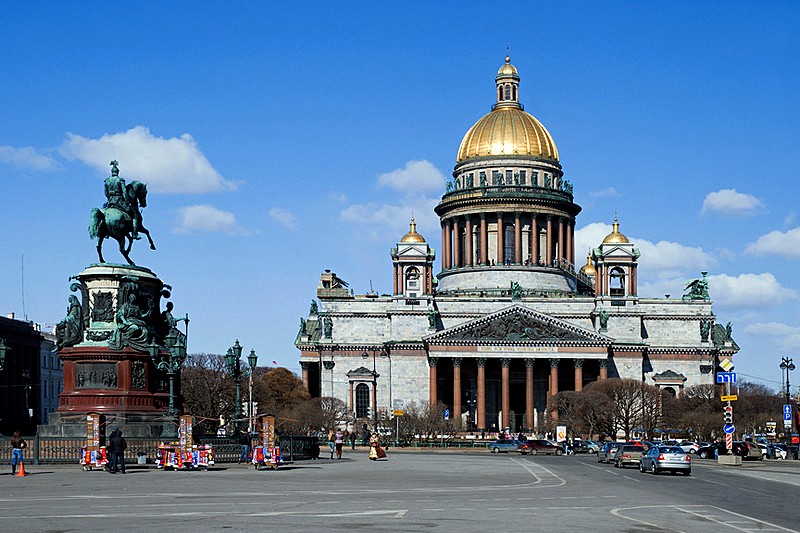French walk No.1 - Beau monde of St. Petersburg
Our first French walk through St. Petersburg starts in one of the oldest quarters of the city, on Vasilyevsky Island where, in the 1720s, in the area to the west of the Menshikov Palace, the first French settlers in the city established a community. Among them were Jean-Baptiste Le Blond, an architect of genius who designed the first plan of St. Petersburg, and the astronomer and cartographer Joseph-Nicolas de L'Isle.

The first address to note is the Academy of Arts building at 17, Universitetskaya Naberezhnaya, built by the great French architect Jean-Baptiste Vallin de la Mothe, who also taught a whole generation of Russian architects the principals of neoclassicism as a professor at the Academy. Other notable French teachers included the artists Jean-Michel Le Jeune Moreau and Louis Jean Francois Lagrenee, and the sculptors Nicolas-Francois Gillet and Louis Rolland. Further along the embankment, we come to the Academy of Sciences building, where several French scientists also worked, including the astronomer Maurice Henri and the classical scholar Jean-Francois Vauvilliers, who had been president of the Commune de Paris during the French Revolution. From there it is a few steps round the corner to the Strelka of Vasilyevsky Island, with the Old Stock Exchange and Rostral Columns, one of the most famous panoramas in the city, designed by Jean-Francois Thomas de Thomon.

Crossing the Neva River via Palace Bridge, we can look up river to the Trinity Bridge, the most beautiful of the Neva bridges, built by the French company Societe de Construction des Batignolles (1897-1903). Next we come to the Winter Palace and the Hermitage. Part of the structure, the so-called Small Hermitage, was built by Vallin de la Mothe, but more significant for most visitors is the wealth of French art to be seen inside the museum, which has masterpieces by Nicolas Poussin and Antoine Watteau as well as its world renowned collection of impressionists and post-impressionists, including Cezanne, Renoir, Gauguin, and Matisse. On the other side of building, Palace Square is dominated by the Alexander Column, erected by Auguste de Montferrand.

We leave Palace Square via Bolshaya Morskaya Ulitsa, where several buildings have French connections. The house at No. 11 was built by the French architect Paul Jaquot, and was prior to that the site of the home and workshops of Maurice Etienne Falconet, the renowned French sculptor who designed the Bronze Horseman. From the 1840s to the 1880s, the first floor of the building was home to Dussault, one of St. Petersburg's most famous French restaurants. In the 1820s, at the corner of Bolshaya Morskaya Ulitsa and Kirpichniy Pereulok, a hexagonal rotunda house a Panorama of Paris, painted from life during the occupation of the city by Russian troops. The nextdoor building (No. 16), became the French Operetta Theatre in the 1850s, attached to which was another renowned French restaurant, the Restaurant Paris run by Georges Cubas. At No. 22, the Societe de Construction des Batignolles had its representative offices, while No. 28 was home to the Alliance Francaise at the beginning of the 20th century. In the 1740s, No. 36 was the house and workshops of Benedict Gravraux, court jeweler to Empress Anna Ioannovna, whose apprentice, the Swiss-born Jeremia Pauzie, became one of the greatest jewelers in Europe.

We follow the street across St. Isaac's Square, with the glorious St. Isaac's Cathedral, the life's work of Auguste de Montferrand. Nearby are two more of his creations, the Demidov Mansion (No. 43) and the Princess Gagarina Mansion (No. 45). At the next junction, we turn right and follow Pochtamtskiy Pereulok to Pochtamtskaya Ulitsa, where at No. 12 lived the soldier and writer Xavier de Maistre, brother of the diplomat and political philosopher Joseph de Maistre. Turning back onto St. Isaac's Square, we pass the house at the end of Pochtamtskaya Ulitsa (9, Isaakievskaya Ploshchad) where Denis Diderot stayed with Prince Naryshkin when visiting his patron, Catherine the Great, in 1773.

Maximilian Joseph Eugene Auguste Napoleon de Beauharnais, Duke of Leuchtenberg, grandson of Empress Josephine, married Maria Nikolayevna, daughter of Nicholas I and lived in the Mariinsky Palace, opposite St. Isaac's Cathedral. He became President of the Imperial Academy of Arts, established a foundry outside St. Petersburg where he experimented with electroplating, providing decorations for St. Isaac's, and founded a free hospital nearby on Voznesenskiy Prospekt.

We now head north-west from the square up to Senate Square (Senatskaya Ploshchad), the site of the famous statue the Bronze Horseman, created by Etienne Maurice Falconet, who spent over a decade working on the monument with the help of his talented assistant, Marie-Anne Collot. We then turn left onto Angliyskaya Naberezhnaya (the English Embankment),where at No. 4 stands the pink neoclassical mansion of Duchess Alexandra Laval. She was the wealthy Russian wife of Jean Charles Francois de Laval de la Loubreriede, a refugee from the French Revolution who became a prominent statesman in the Ministry of Foreign Affairs. Their home, reconstructed by Jean-Francois Thomas de Thomon, became one of the most fashionable addresses in the city - Alexander Pushkin and Mikhail Lermontov both read their verses there, and even Alexander I was among the guests. Here we finish the walking tour, directly across the Neva River from where we began.

